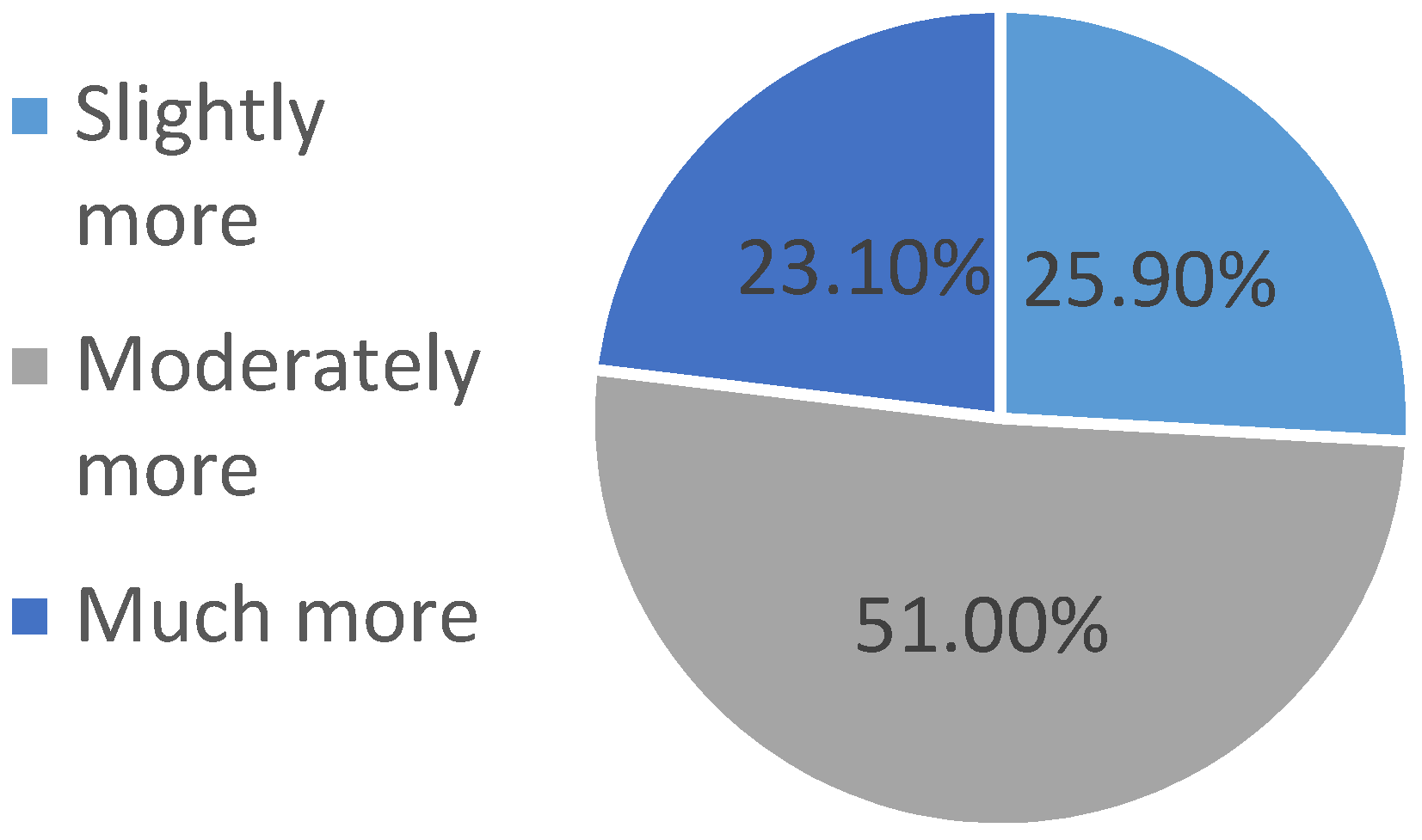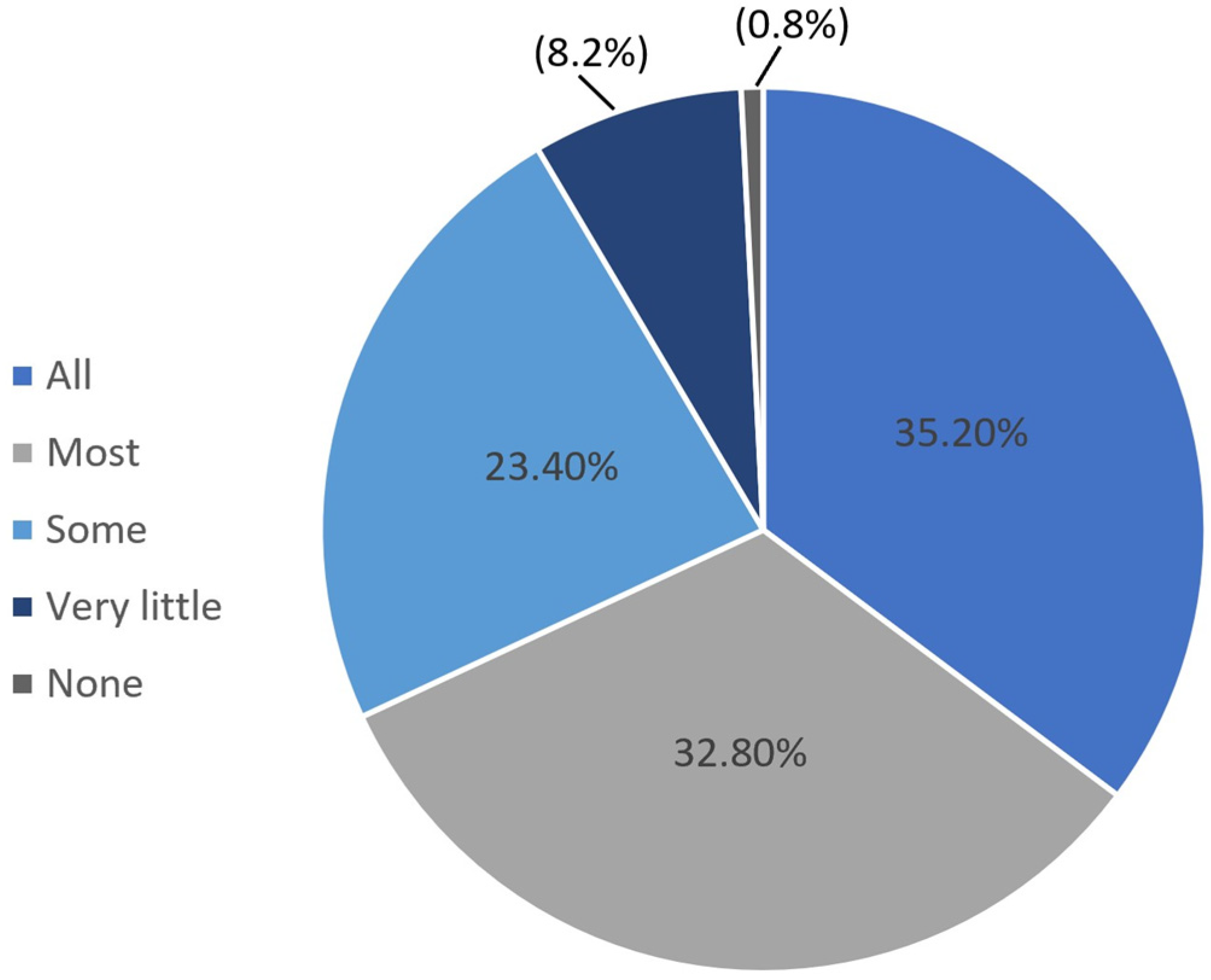COVID-19-Related Changes in Perceived Household Food Waste in the United States: A Cross-Sectional Descriptive Study
Abstract
1. Introduction
2. Materials and Methods
2.1. COVID-19 and Food Waste Questionnaire
2.2. Data Collection
2.3. Statistical Analyses
3. Results
3.1. Demographics and Household Characteristics
3.2. COVID-19-Related Household Changes
3.3. COVID-19-Related Food Behavior Changes
3.4. COVID-19-Related Household Food Waste Changes
3.5. Impact of Lifestyle Disruptions and Food-Related Behaviors on Household Food Waste
3.6. Contribution of Different Food Groups to Household Food Waste
4. Discussion
5. Conclusions
Author Contributions
Funding
Institutional Review Board Statement
Informed Consent Statement
Data Availability Statement
Acknowledgments
Conflicts of Interest
References
- World Health Organization WHO Director-General’s Opening Remarks at the Media Briefing on COVID-19—11 March 2020. Available online: https://www.who.int/director-general/speeches/detail/who-director-general-s-opening-remarks-at-the-media-briefing-on-covid-19---11-march-2020 (accessed on 15 November 2020).
- Lin, G.; Zhang, T.; Zhang, Y.; Wang, Q. Statewide Stay-At-Home Directives on the Spread of COVID-19 in Metropolitan and Nonmetropolitan Counties in the United States. J. Rural Health 2020, 1–2. [Google Scholar] [CrossRef] [PubMed]
- Di Renzo, L.; Gualtieri, P.; Pivari, F.; Soldati, L.; Attinà, A.; Cinelli, G.; Cinelli, G.; Leggeri, C.; Caparello, G.; Barrea, L.; et al. Eating habits and lifestyle changes during COVID-19 lockdown: An Italian survey. J. Transl. Med. 2020, 18, 1–15. [Google Scholar] [CrossRef] [PubMed]
- Bánhidi, M.; Lacza, G. Lifestyle changes during Covid-19 period in Hungary–feedback of university students. World Leis. J. 2020, 62, 325–330. [Google Scholar] [CrossRef]
- Rundle, A.G.; Park, Y.; Herbstman, J.B.; Kinsey, E.W.; Wang, Y.C. COVID-19–Related School Closings and Risk of Weight Gain Among Children. Obesity 2020, 28, 1008–1009. [Google Scholar] [CrossRef] [PubMed]
- Jia, P.; Liu, L.; Xie, X.; Yuan, C.; Chen, H.; Guo, B.; Zhou, J.; Yang, S. Impacts of COVID-19 lockdown on diet patterns among youths in China: The COVID-19 Impact on Lifestyle Change Survey (COINLICS). Appetite 2020, 158, 105015. [Google Scholar] [CrossRef]
- Đogaš, Z.; Kalcina, L.L.; Dodig, I.P.; Demirović, S.; Madirazza, K.; Valić, M.; Pecotić, R. The effect of COVID-19 lockdown on lifestyle and mood in Croatian general population: A cross-sectional study. Croat. Med. J. 2020, 61, 309–318. [Google Scholar] [CrossRef]
- Appelhans, B.M.; French, S.A.; Tangney, C.C.; Powell, L.M.; Wang, Y. To what extent do food purchases reflect shoppers’ diet quality and nutrient intake? Int. J. Behav. Nutr. Phys. Act. 2017, 14, 1–10. [Google Scholar] [CrossRef]
- Devereux, S.; Béné, C.; Hoddinott, J. Conceptualising COVID-19’s impacts on household food security. Food Secur. 2020, 12, 769–772. [Google Scholar] [CrossRef]
- Benker, B. Stockpiling as resilience: Defending and contextualising extra food procurement during lockdown. Appetite 2021, 156, 104981. [Google Scholar] [CrossRef]
- De Almeida, S.V.; Costa, E.; Lopes, F.V.; Santos, J.V.; Barros, P.P. Concerns and adjustments: How the Portuguese population met COVID-19. PLoS ONE 2020, 15, 1–17. [Google Scholar]
- Hao, N.; Wang, H.H.; Zhou, Q. The impact of online grocery shopping on stockpile behavior in Covid-19. China Agric. Econ. Rev. 2020, 12, 459–470. [Google Scholar] [CrossRef]
- United Nations Transforming Our World: The 2030 Agenda for Sustainable Development. Available online: https://sustainabledevelopment.un.org/post2015/transformingourworld (accessed on 15 November 2020).
- Food and Agriculture Association of the United Nations. Food Wastage Footprint: Full-Cost Accounting. 2014. Available online: http://www.fao.org/3/a-i3991e.pdf (accessed on 17 November 2020).
- Conrad, Z.; Niles, M.T.; Neher, D.A.; Roy, E.D.; Tichenor, N.E.; Jahns, L. Relationship between food waste, diet quality, and environmental sustainability. PLoS ONE 2018, 13, 1–18. [Google Scholar] [CrossRef] [PubMed]
- Venkat, K. The Climate Change and Economic Impacts of Food Waste in the United States. Int. J. Food Syst. Dyn. 2012, 2, 431–446. [Google Scholar]
- Parfitt, J.; Barthel, M.; MacNaughton, S. Food waste within food supply chains: Quantification and potential for change to 2050. Philos. Trans. R. Soc. B Biol. Sci. 2010, 365, 3065–3081. [Google Scholar] [CrossRef] [PubMed]
- National Academies of Sciences Engineering and Medicine. A National Strategy to Reduce Food Waste at the Consumer Level. 2020. Available online: https://www.nap.edu/catalog/25876/a-national-strategy-to-reduce-food-waste-at-the-consumer-level (accessed on 20 November 2020).
- Principato, L.; Secondi, L.; Cicatiello, C.; Mattia, G. Caring more about food: The unexpected positive effect of the Covid-19 lockdown on household food management and waste. Socioecon. Plann. Sci. 2020, 100953. [Google Scholar] [CrossRef]
- Pappalardo, G.; Cerroni, S.; Nayga, R.M.; Yang, W. Impact of Covid-19 on Household Food Waste: The Case of Italy. Front. Nutr. 2020, 7, 1–9. [Google Scholar] [CrossRef] [PubMed]
- Jribi, S.; Ben Ismail, H.; Doggui, D.; Debbabi, H. COVID-19 virus outbreak lockdown: What impacts on household food wastage? Environ. Dev. Sustain. 2020, 22, 3939–3955. [Google Scholar] [CrossRef] [PubMed]
- Ismail, M.H.; Ghazi, T.I.M.; Hamzah, M.H.; Manaf, L.A.; Tahir, R.M.; Nasir, A.M.; Omar, A.E. Impact of movement control order (Mco) due to coronavirus disease (covid-19) on food waste generation: A case study in klang valley, malaysia. Sustainability 2020, 12, 1–17. [Google Scholar]
- Aldaco, R.; Hoehn, D.; Laso, J.; Margallo, M.; Ruiz-Salmón, J.; Cristobal, J.; Kahhat, R.; Villanueva-Rey, P.; Bala, A.; Batlle-Bayer, L.; et al. Food waste management during the COVID-19 outbreak: A holistic climate, economic and nutritional approach. Sci. Total Environ. 2020, 742, 140524. [Google Scholar] [CrossRef]
- Sarkodie, S.A.; Owusu, P.A. Impact of COVID-19 pandemic on waste management. Environ. Dev. Sustain. 2020. [Google Scholar] [CrossRef]
- US Census Household Pulse Survey: Measuring Social and Economic Impacts during the Coronavirus Pandemic. Available online: https://www2.census.gov/programs-surveys/demo/technical-documentation/hhp/Phase3_Questionnaire_11_4_20_English.pdf (accessed on 20 November 2020).
- Wharton, C.; Vizcaino, M.; Berardy, A.; Opejin, A. Waste watchers: A food waste reduction intervention among households in Arizona. Resour. Conserv. Recycl. 2021, 164, 105109. [Google Scholar] [CrossRef]
- Paolacci, G.; Chandler, J.; Ipeirotis, P.G. Running experiments on Amazon mechanical turk. Judgm. Decis. Mak. 2010, 5, 411–419. [Google Scholar]
- Paolacci, G.; Chandler, J. Inside the Turk: Understanding Mechanical Turk as a Participant Pool. Curr. Dir. Psychol. Sci. 2014, 23, 184–188. [Google Scholar] [CrossRef]
- Mason, W.; Suri, S. Conducting behavioral research on Amazon’s Mechanical Turk. Behav. Res. Methods 2012, 44, 1–23. [Google Scholar] [CrossRef]
- Burrell, D.N. Understanding the Talent Management Intricacies of Remote Cybersecurity Teams in Covid-19 Induced Telework Organizational Ecosystems. Land Forces Acad. Rev. 2020, 25, 232–244. [Google Scholar] [CrossRef]
- Ben Hassen, T.; El Bilali, H.; Allahyari, M.S. Impact of COVID-19 on Food Behavior and Consumption in Qatar. Sustainability 2020, 12, 6973. [Google Scholar] [CrossRef]
- Sirola, N.; Sutinen, U.M.; Närvänen, E.; Mesiranta, N.; Mattila, M. Mottainai!-A practice theoretical analysis of Japanese consumers’ food waste reduction. Sustainability 2019, 11, 6645. [Google Scholar] [CrossRef]
- Brizi, A.; Biraglia, A. “Do I have enough food?” How need for cognitive closure and gender impact stockpiling and food waste during the COVID-19 pandemic: A cross-national study in India and the United States of America. Personal. Individ. Dif. 2021, 168, 110396. [Google Scholar] [CrossRef]
- Haug, A.; Brand-Miller, J.C.; Christophersen, O.A.; McArthur, J.; Fayet, F.; Truswell, S. A food “lifeboat”: Food and nutrition considerations in the Event of a Pandemic or Other Catastrophe. Med. J. Aust. 2007, 187, 11–13. [Google Scholar] [CrossRef]
- Bian, B.; Li, J.; Xu, T.; Foutz, N. Individualism During Crises. SSRN Electron. J. 2020, 1–57. [Google Scholar] [CrossRef]
- Grasso, A.C.; Olthof, M.R.; Boevé, A.J.; van Dooren, C.; Lähteenmäki, L.; Brouwer, I.A. Socio-demographic predictors of food waste behavior in Denmark and Spain. Sustainability 2019, 11, 3244. [Google Scholar] [CrossRef]
- Cantaragiu, R. The Impact of Gender on Food Waste at the Consumer Level. Stud. Univ. Vasile Goldis Arad-Econ. Ser. 2019, 29, 41–57. [Google Scholar] [CrossRef]
- Richter, B. Knowledge and perception of food waste among German consumers. J. Clean. Prod. 2017, 166, 641–648. [Google Scholar] [CrossRef]
- Grainger, M.J.; Aramyan, L.; Logatcheva, K.; Piras, S.; Righi, S.; Setti, M.; Vittuari, M.; Stewart, G.B. The use of systems models to identify food waste drivers. Glob. Food Sec. 2018, 16, 1–8. [Google Scholar] [CrossRef]




| Frequency | Percentage | |
|---|---|---|
| Sex | ||
| Male | 486 | 51.4 |
| Female | 460 | 48.6 |
| Age range (years) | ||
| 20–29 | 199 | 21.0 |
| 30–39 | 331 | 35.0 |
| 40–49 | 200 | 21.1 |
| 50–69 | 216 | 22.8 |
| Education | ||
| Less than high school | 3 | 0.3 |
| Some high school | 1 | 0.1 |
| High school graduate | 48 | 5.1 |
| Some college | 103 | 10.9 |
| Associate’s degree | 83 | 8.8 |
| Bachelor’s degree | 562 | 59.4 |
| Graduate degree | 146 | 15.4 |
| Marital status | ||
| Married | 623 | 65.9 |
| Widowed | 23 | 2.4 |
| Divorced | 63 | 6.7 |
| Separated | 15 | 1.6 |
| Never married | 222 | 23.5 |
| Frequency | Percentage | |
|---|---|---|
| Household income | ||
| Less than $25,000 | 124 | 13.1 |
| $25,000–$34,999 | 89 | 9.4 |
| $35,000–$49,999 | 172 | 18.2 |
| $50,000–$74,999 | 273 | 28.9 |
| $75,000–$99,999 | 153 | 16.2 |
| $100,000–$149,999 | 96 | 10.1 |
| $150,000–$199,999 | 22 | 2.3 |
| $200,000+ | 17 | 1.8 |
| Household size | ||
| 1 | 129 | 13.7 |
| 2 | 215 | 22.8 |
| 3 | 183 | 19.4 |
| 4 | 274 | 29.0 |
| 5+ | 143 | 15.1 |
| Number of children | ||
| 0 | 357 | 37.7 |
| 1 | 263 | 27.8 |
| 2 | 246 | 26.0 |
| 3 | 41 | 4.3 |
| 4+ | 39 | 4.1 |
Publisher’s Note: MDPI stays neutral with regard to jurisdictional claims in published maps and institutional affiliations. |
© 2021 by the authors. Licensee MDPI, Basel, Switzerland. This article is an open access article distributed under the terms and conditions of the Creative Commons Attribution (CC BY) license (http://creativecommons.org/licenses/by/4.0/).
Share and Cite
Cosgrove, K.; Vizcaino, M.; Wharton, C. COVID-19-Related Changes in Perceived Household Food Waste in the United States: A Cross-Sectional Descriptive Study. Int. J. Environ. Res. Public Health 2021, 18, 1104. https://doi.org/10.3390/ijerph18031104
Cosgrove K, Vizcaino M, Wharton C. COVID-19-Related Changes in Perceived Household Food Waste in the United States: A Cross-Sectional Descriptive Study. International Journal of Environmental Research and Public Health. 2021; 18(3):1104. https://doi.org/10.3390/ijerph18031104
Chicago/Turabian StyleCosgrove, Kelly, Maricarmen Vizcaino, and Christopher Wharton. 2021. "COVID-19-Related Changes in Perceived Household Food Waste in the United States: A Cross-Sectional Descriptive Study" International Journal of Environmental Research and Public Health 18, no. 3: 1104. https://doi.org/10.3390/ijerph18031104
APA StyleCosgrove, K., Vizcaino, M., & Wharton, C. (2021). COVID-19-Related Changes in Perceived Household Food Waste in the United States: A Cross-Sectional Descriptive Study. International Journal of Environmental Research and Public Health, 18(3), 1104. https://doi.org/10.3390/ijerph18031104





